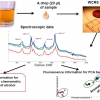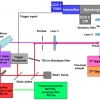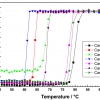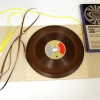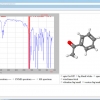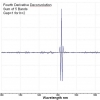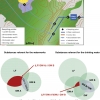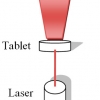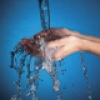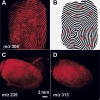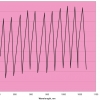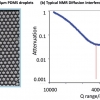Praveen Ashok and Kishan Dholakia of St Andrews University, UK, describe the scope of optofluidic devices that can be implemented using the waveguide confined Raman spectroscopy (WCRS) technique they have developed. I am particularly impressed by the sample size of whisky shown in Figure 2—true Scottish style!
Articles and Columns
Pages
Peter Jenks gains new respect for microbiologists and learns that the way they approach analytical quality control is different from chemists.
Since attempts to blow up planes using liquid explosives, we have all been restricted in what we can take onboard when we fly. Raman spectroscopy is offering a solution. However, “Time-resolved Raman spectroscopy for non-invasive detection through non-transparent materials” by Ingeborg Iping Petterson and Freek Ariese argues that time-resolved Raman spectroscopy (TRRS) techniques provide better spatial selectivity than the major alternative, spatially offset Raman spectroscopy (SORS). Applications for through-skin measurements and depth analysis in catalytic extrudates are also described.
In the pharmaceutical industry, biologicals are of increasing interest due to their high therapeutic benefits. Amongst many other questions, the stability of new canditates is of great importance. Patrick Garidel describes this in “Right angle light scattering protein thermostability screening: from research to development”. The ability of this and other fluorescence-based techniques to detect very small quantities is of great benefit.
Do you remember magnetic tape-to-tape recorders and players? In any case, I am sure you will be interested in this article looking at the use of FT-IR spectroscopy to help the conservation of tapes in the collection of the National Museums Berlin. In “ATR/FT-IR spectroscopy for the characterisation of magnetic tape materials”, Elena Gómez-Sánchez, Simon Kunz and Stefan Simon describe how by investigating the state of the base layer of the tape, conservation efforts can be prioritised to those tapes in most immediate danger.
Tony (A.N.) Davies is after your advice in his latest column “Your committee needs you!”. The IUPAC Subcommittee on Electronic Data Standards is keen to learn about areas where you would like to see improvements in moving your data between your analytical instruments and data analysis and reporting packages.
This Tony Davies Column is contributed by Karl Norris, known to many as “The father of near infrared spectroscopy”. He introduces his calculation method for fourth derivatives and shows how it can be used to extract instrument noise.
Monitoring drinking water quality poses many challenges and the authors describe their approach that combines instrumental developments with new software.
With the threat of climate change, understanding the workings of our atmosphere is of crucial importance. Ozone is the most important trace gas in the stratosphere and troposphere and it is monitored by both satellite-borne and ground-based instruments. Accurate knowledge of ozone absorption cross-sections is vital for this work and described in this article.
Counterfeiting is a major problem throughout the world and transmission Raman spectroscopy proves to be a very useful tool for fast and non-destructive detection of counterfeit pharmaceuticals.
The African crested rat chews poisonous bark and then applies its saliva to specialised hairs which provide a most effective protection. Maxime Boulet-Audet and Chris Holland describe this and the use of infrared spectroscopy to learn more about this unusual animal. The new knowledge may even lead to new treatments for human cardiac conditions.
Chris Burgess and John Hammond respond to Peter Jenks' thoughts in the last issue's Quality Matters Column. Please join in the debate and add your comments at the end of the article.
Chemical contaminants in water are of concern to all of us. This article reviews the use of mass spectrometry (MS) in environmental and wastewater analysis.
After an introduction to MALDI, DESI and SIMS, the authors describe their main applications in forensics, as well as the advantages provided in terms of sample preparation over approaches routinely used in toxicological laboratories.
Industrial environments pose potentially hazardous situations whereby workers may be exposed to various airborne toxic elements in their breathing zone. One of the main aerosol fractions of interest is welding fume, which can be determined with XRF spectrometry.
Tony (A.N.) Davies is impressed with the service form the UK's EPSRC National Mass Spectrometry Service Centre.
Tea is harvested from the bud, the first leaf and the first three leaves up to a maximum of four leaves. Quality decreases from the bud down as the parts become older. This study looks at the use of NIR spectroscopy to determine optimal production using the harvested material.
Tony (A.M.C.) Davies is again telling us to “Always look at the spectrum”. This time he uses an example from the development of a NIR spectrometer to demonstrate that one doesn’t really know what’s going on until one has “looked at the spectrum”.
The reasoning behind strict compliance to an ISO Standard is logical, but the consequences can be commercially questionable, if not unsound. Peter Jenks, and many other scientists, are starting to question the commercial viability of all this regulation. What is your opinion?
Nuclear magnetic resonance (NMR) spectroscopy is one of the most powerful analytical tools used to probe details of molecular structure and dynamics. It requires very high magnetic fields and, hence, generally uses extremely large, powerful magnets. The advent of small, powerful magnets has allowed much less expensive low resolution NMR instrumentation to be designed, making it feasible to measure commercially important characteristics of dispersion behaviour and performance, including the wetted surface area of particulate suspensions and emulsion droplet size. An important additional practical application is the ability to determine competitive adsorption and/or displacement of polymers and surfactants at interfaces. This article presents a brief overview of these new approaches together with an example of each measurement.

